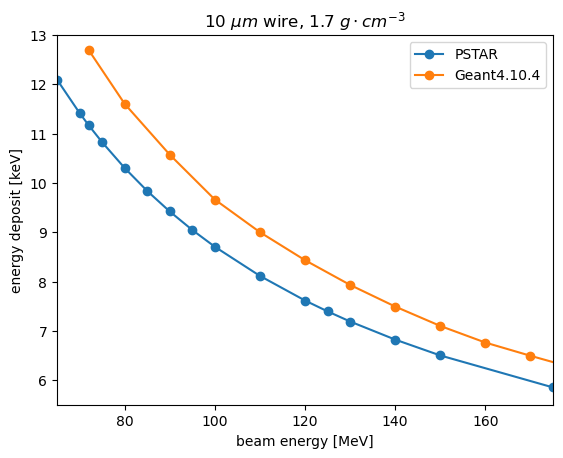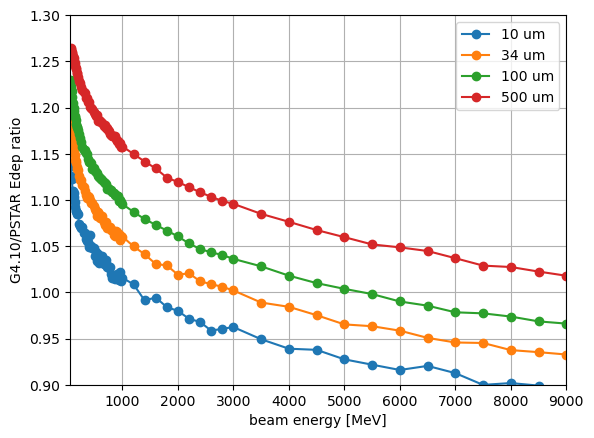Good morning,
which physics list is recommended for estimation of energy deposition in thin targets (10 um)? And what about delta electrons, is there a list which gives particularly accurate results?
Finally I’m also interested in secondary emission yield.
My beam is protons between 100 MeV and 100 GeV.
Thanks in advance, Mariusz
Hi, I would use G4EMStandard_opt4, with a very low cut (e.g. 100 eV)
Hi,
I got a bit puzzling results when comparing energy deposition in Geant4 to PSTAR dEdx. Geant4 is higher than PSTAR what is strange. I have a very thin target (10 um carbon wire), so I would expect that PSTAR, which does not take into account escaping delta electrons, would give lower numbers than Geant4. What do you think?

Hi,
your structure is very thin, so probably the particle deposits all its energy in the first step. You should reduce the step (e.g. 2 micrometers) . Which cut do you adopt?
If you would like to reproduce the results of PSTAR, you should switch off the multiple scattering and the energy loss fluctuations. Then, you should increase the cut such that no secondary particle is produced. . The step should be small and the target “semi-infinite”. This is how the CSDA (considered in PSTAR) is obtained.
Cheers
Susanna
Hi Susana,
thank you for prompt answer. My goal is not to reproduce PSTAR but to get the most accurate estimation of the energy deposited in the target. I’m coming back to Geant4 after many years so I forgot many things and also Geant4 evolved a lot. For those results I set up the following cut in my macro file:
/run/setCut 0.05 um
Is this enough? From the past I remember that I was also changing a cut in the code itself, before compilation, but I don’t know if it is still needed.
I’ve tried a few different physics list to see if there is a difference, but there is no. Interestingly, above proton energy of 1.3 GeV, the Geant4 predictions are getting lower than PSTAR. How would you interpret this? Also the discrepancy G4/PSTAR is larger for thicker target.
Best regards, Mariusz

Here is the plot for various thicknesses.
Cheers, Mariusz

Hi, the cut should be fine. I suggest to limit the particle step so that you will get a more accurate description of edep.
One thing I do not understand is why you want to compare your edep to PSTAR as the two physical quantities are not the same.
Cheers
Susanna
Hello, what command should be used to limit the particle step?
The story of using PSTAR is that we needed Eden estimation for the thin target and initially we used PSTAR as this is the fastest way to get this info. However I remembered that for high beam energies delta electrons carry away a lot of deposited energy, so PSTAR values cannot be directly used. At the end I had time to run Geant4 and to my surprise I’ve found that Geant4 prediction is actually higher than PSTAR in this energy range. This is when I’ve started asking questions at this forum.
Cheers, Mariusz
I think you have higher edep with Geant4 because the step needs to be limited (at least this is my impression). You have to add the StepLimiter as a process in the physics list and then define the maximum step in the element of geometry in the Detector Construction. I suggest to check the Application Developer Manual and the Geant4 examples for details.
Hello,
first of all, proton ionisation is the same in any reference physics list. The cut should be set to be less than thickness of the layer in this case below 10 um. The PSTAR data are the data for total DEDX and CSDA range. These data are no equal with energy deposition in thin layers. Also one should not change anything in the code for study of energy deposition (as before).
VI